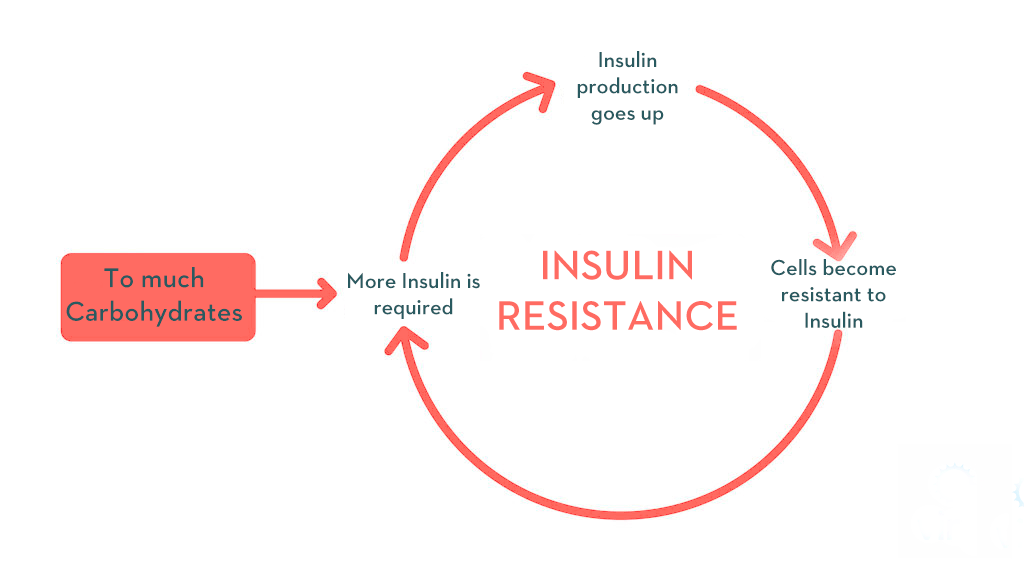

written by : DOMINIK VANYI
translated from Indonesian by: JAH DEWA GAUTAMA
Only when we understand that Type-2 Diabetes is actually Hyperinsulinemia & Insulin Resistance, can we begin to treat it properly…
Diabetes Mellitus has become a plague worldwide, with hundreds of Million of people being affected globally. And the number is growing steadily.
Take a look at the US, approximately 30% of the entire population suffer from Type-2 Diabetes.
Unfortunately, by considering Diabetes Mellitus as a ‘High Blood Sugar’ problem, many people treat it in a less than optimal way. And that’s me being rather diplomatic.
Sufferers of Diabetes have high glucose (sugar) levels within their blood – no question. And these high concentrations of glucose in the blood have the potential to be dangerous if left untreated. Again no question about that.
However, in order to treat it well and to even cure it, we must dig a little deeper and find the root cause. And in digging to the core of the issue, we will find what is causing the illness.
One more time just in case, too much Glucose is not a cause, just a symptom.
Forgive me, it’s so important that you can count on me repeating it again.
If you are still unsure about this, please leave a comment below.
What Causes High Blood Glucose levels?
If you’d ask: “What is Type-2 Diabetes?” most doctors will answer that it is an illness caused by too much glucose, or sugar, within your blood.
It is comparable to saying that a heavy smoker is coughing because their lungs are sick. But the reason the lungs are sick is because of the smoking.
To get to the core of our question, we must first take a look at why those who suffer from Type-2 Diabetes have high blood glucose levels.
I am sure you heard the term: Insulin Resistance before. Now this is a more accurate way of referring to this disease.
In understanding what Insulin Resistance is, will we get into the core of Type-2 Diabetes.
To understand what Insulin Resistance is, we should understand the role Insulin has. Short and simple – I promise.
If you still do not understand what Glucose is, it is what is commonly referred to as Blood Sugar. If you want to find out more about what Glucose is, please have a read of this: Glucose and Blood Sugar – What exactly are they?
As our blood glucose levels increase, Insulin will be produced to designate the Glucose to the cells in our body. Which need the glucose in order to make energy.
What happens is that the Insulin, knocks on the ‘doors’ of the cells who open up and allow the glucose inside.
And as long as we are healthy, the process of transporting the Glucose into the cells goes smoothly.
But, if we become Insulin Resistant our cells no longer want to accept any more Glucose. However, getting to the point of ‘not letting the glucose in’ is a slow and gradual process.
Insulin resistance actually develops years before there are any symptoms of Type-2 Diabetes.
Insulin resistance does not only cause Diabetes but an array of other diseases and complications.

Next, I am going to explain why Insulin resistance is a Vicious Cycle.
To paint a clearer picture, we shall use a metaphor.
Imagine this: Knocking on the door of a cell to let in the Glucose requires one ‘unit’ of Insulin.
In the case that we consume too much sugar and carbohydrates, our cells become ‘lazy’ and will not accept any more glucose. They simply will not open the door for the Insulin anymore.
And because the Glucose levels in the blood remain high, our bodies just produce more and more Insulin. This is because it is dangerous to have too much glucose in your blood.
In order to knock harder in the efforts to bring glucose into the cells, it now requires the equivalent to 1.5 ‘units’ of Insulin.
Not long after that, 1.5 ‘units’ will no longer be enough. And now we need 2.
What follows is a gradual increase in how much Insulin is needed to get the attention of the cells. And the body obliges by producing more and more Insulin.
And here the cycle continues as the cells in the body become more stubborn toward the knocks from the Insulin. And all the while, glucose is not entering the cells.
The cells are increasingly stubborn, and the body just produces more. The cycle goes on and on….
This phenomenon is what we call, Insulin resistance.
After some time, the levels of Insulin become dangerously high. A condition called Hyperinsulinemia. The amount of Insulin needed by someone who suffers greatly can be 3-4x the amount of healthy person’s. This process is already happening for a few years before the individual will start to show symptoms of Type-2 Diabetes.
But the need for more Insulin is not the only problem… There is another mechanism that plays a role in this vicious cycle.
Those of you who have lived in a big city will relate to this next aspect quite closely. TRAFFIC!
In a big metropolis like London, it takes around half an hour to get from the city centre to the outskirts. But with traffic, this same journey could take 1-2 hours, sometimes even 3.
As well as a waste of time, you are also wasting valuable energy in your engine being on the entire time.
Well, this is more or less what is happening when we become Insulin resistant. This is due to our cells becoming too full and lazy to accept Glucose, which means the Insulin will take longer to do its job.
For example: If a normal, healthy person would drink a soft drink their Insulin levels will spike up for around half an hour. Because of this, the glucose within the drink will be let into our cells. Done.
Meanwhile, in the body of someone who suffers from Type-2 Diabetes, the Insulin needs much more time to ‘handle’ the Glucose and get them into the cells.
The result is that the Insulin levels remain high for longer. Maybe even for hours. Diabetics will recognise the phenomena of: Blood sugar levels never decreasing.
This is becoming a problem because the ‘modern human’ loves to snack and drink sweet things, which means glucose has to be processed constantly.
Over time, all of this causes the Vicious Cycle only to spin faster.
The body’s need for Insulin increases and the level of Insulin in the blood never goes down.
This causes glucose levels to rise as well because of the queue caused by the cells not letting them in.
If a sufferer leaves their condition untreated, it could result in a whole new problem arising. The organ that produces Insulin, the Pancreas may then be damaged to the point that it can no longer produce Insulin.

More and mor Insulin is needed
Of course!😉
Up to 80% of Type-2 Diabetes sufferers are able to pull themselves out of this vicious cycle.
But the solution is not medicine. Because too much medicine will only increase the production of Insulin. This is especially bad when patients are given Insulin based medication.
Giving supplemental Insulin to a Type-2 Diabetic can be likened to putting out a fire with gasoline…
In doing so, the vicious cycle is maintained and will continue to increase in its severity.
FYI: There are patients who suffer from Diabetes Mellitus but require Insulin based medicine (external insulin).
This happens when the Pancreas is no longer able to produce enough Insulin. But these types of Type-2 Diabetes sufferers are few and far between. Only about 10% of those who have the illness.
And for these patients, there is a big chance that their dependence on Insulin supplements can be stopped.
One of the ways in which someone can get out of this cycle is to slow the process down. This can be done by adapting your dietary intake. You can take it a step further by changing your eating patterns, and to reach full effectiveness, accompany this with fasting.
In summary, there are two actions one must take. And both are aimed at reducing your need for Insulin.
The first is to reduce the amount of sugars and carbohydrates in your diet
The second is to reduce the frequency with which you eat
What do I mean by reducing the frequency with which you eat?
Well, some of you may be more familiar to this concept than others, namely those of the Islamic faith. Fasting.
There are many ways to fast, and these methods have been proven to have some prominent health benefits and can help in reducing illnesses.
For example, you can do some long-term fasting – going without food for days on end. Or just having a single meal a day. You can even mix it up and fast one day, and eat the next and so on. And if you are not a fan of patterns, how about eating for five days and then refrain from eating for the next two.
Honestly, I could go on. But I don’t need to bombard you with different types of fasting because what will work for you may not work for others. The ideal method depends on your individual situation and condition.
If you DO want to learn about the different ‘healthy’ fasting methods, please have a gander at this article: HOW TO FAST FOR HEALTH.
Type-2 Diabetes is not solely a blood sugar (glucose) problem, but one that is closely linked with Insulin. Or what is referred to as Insulin Resistance.
And no sort of medicine will EVER be able to completely resolve the Insulin resistance problem that leads to Type-2 Diabetes.
Only by modifying your eating frequency and schedule can you truly treat and even cure yourself of Type-2 Diabetes.
The majority of Type-2 Diabetes sufferers are able to cure themselves without the help of medicine.
If overeating and poor diets cause Type-2 Diabetes, then it should be obvious that changing those two habits can lead to the curing of the disease.
It makes total sense.
If you still have any questions, please leave a comment below, or reach me directly.
If you want a clearer understanding of what Insulin Resistance is, I recommend you this article: Insulin Resistance – What is it?
P.S. If you are a more visual learner, how about you have a look at one of Dr. Jason Fung’s videos: The Big Lies about Type 2 Diabetes.
👉Greetings from wonderful BALI👈
DOMINIK🙏🙏🙏

0 Comments